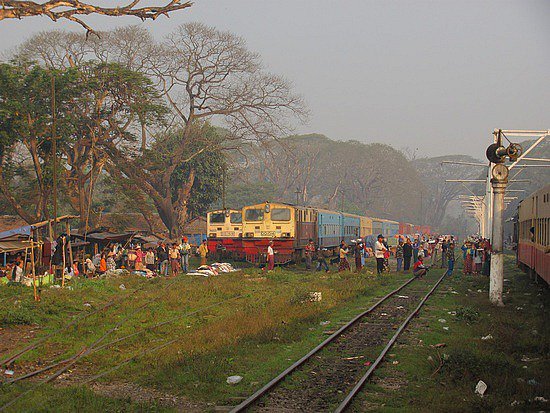Myitkyina is the capital of kachin state,locating on the bank of Irrawaddy river.It is the third biggest city of Myanmar,bordered with China and India.
Many tribes of people like Burmese,Shan,Muslim etc... Live here.
Myitkyina With a population of around 150,000, Myitkyina, the capital of Kachin State has been a strategic domestic and international trading post for centuries. It's importance is reflected in its varied ethnic composition, which includes Bamar, Shan and Kachin people and small populations of Indians and Chinese. The city is located near both the source of the Irrawaddy River and also Indawgyi Lake, one of the largest inland lakes in South East Asia. Like Putao, it makes a wonderful base for a few days trekking, visiting Kachin villages as you stroll in the sunshine among the forested hillsides. It's an obvious stop on any route north, reached either by train or by air from Mandalay. Myitkyina travel Practical info The Practical information displayed here is taken from The Traveller's Handbook, published by WEXAS (2009). While all possible care was taken to ensure accuracy at the time of publication, we are aware that situations change, so for the latest information and up-to-date visa requirements, talk to one of our destination specialists on 020 7590 0613. Weather The cool and dry winter is from November to February, the hot summer is from March to May and the wet, humid monsoon from May to October. A dry-zone between Mandalay and Pyay gets less rain than the rest of the country. Festivals Myanmar celebrates a number of Buddhist festivals, many of which coincide with the full moon. Other annual events include the Pindaya Cave Festival in March, the Thingyan (water) Festival for Myanmar New Year in April, where people pour water over each other, and Thadingyut, the Festival of Light, in October. The Elephant Dance Festival, also in October, is a thunderous event in Kyaukse where life-size elephants made of bamboo and paper are followed by traditional musicians. Theatre, known as pwe, and traditional dance sometimes form a ritual part of religious festivals and can also be witnessed at weddings, sporting events and even funerals. Food & drink Dishes include lethok son (vegetarian rice salad), oh-no khauk swe (rice noodles, chicken and coconut milk), mohinga (fish soup with noodles). Street food includes chapattis. Tea is popular (often added spices may make your tongue turn red). Etiquette It is not advisable to discuss politics with locals as this may get them into trouble. The question of whether it is ethically right to travel to Myanmar is an ongoing debate. The leader of the opposition party, Aung San Suu Kyi, has urged tourists to boycott Myanmar. Many argue that to visit is to support the country financially and justify the junta in the eyes of the international community. Others, including Lonely Planet whose guide suggests how to minimise the financial benefit to the government, argue that tourism can help curb the isolation and abuse of Burmese people. Safety Myanmar is ruled by a military junta which suppresses almost all dissent and wields absolute power in the face of international condemnation and sanctions. It is considered one of the world's most repressive regimes, accused of human rights abuses and corruption. Ethnic rebels continue to fight the government and travel to Karen, Shan, Karenni, Chin and Arakanese areas should be avoided. Additionally, Myanmar's infrastructure remains in tatters following the devastating Cyclone Nargis in 2008. Seek latest advice before travel. International airport Yangon (RGN) 19 km from the city and Mandalay (MDL) 25 km from the city. Internal travel Air travel is the most efficient transport for time-saving. Rail services are subject to delays caused by climatic, technical and bureaucratic difficulties. Bus services are uncomfortable. Government-run taxis are blue and white. Visa Required. Vaccination BCG, Cholera, Diphtheria, Hep. A, Hep. B, JE, Malaria, Polio, Rabies, Typhoid, Y. Fever2. Driving Those wishing to drive must apply for a Myanmar licence at the Department for Road Transport and Administration in Yangon. Capital Nay Pyi Taw is the country's official administrative capital, a closely guarded and isolated town 320 km north of Yangon - the former capital and the city in which foreign embassies are still based. Language Burmese and other ethnic minority languages. People Burman (68%), Shan (9%), Karen (7%), Rakhine (4%), Chinese, Indian and Mon. Religion Buddhist (89%). Christian, Muslim, animist. Size 678,500. Population 47,758,181. Population density 70.3. Life expectancy 60.73, F 65.28. Currency Kyat (K) = 100 pyas. Finance Credit cards are unlikely to be accepted. Traveller's cheques not accepted. Business hours




No comments:
Post a Comment